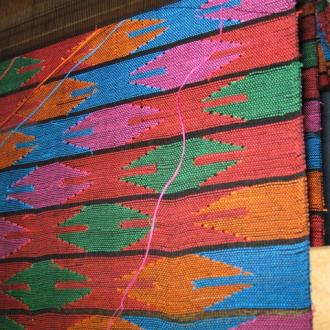
Hema Bhuljal is an excellent weaver who draws on long experience at the frame loom from when she worked in the refugee camp craft workshop for years in Nepal. Like all of the Nepali-speaking Bhutanese weavers now resettling in Worcester, Hema and her family were targeted by the nationalistic, xenophobic Bhutanese federal government as “outsiders” (though they were hardly that, having lived and farmed in Bhutan for over a century). Hema and her kin fled Bhutan for safety to U.N.-sponsored refugee camps over the border in Nepal. There, they waited for decades for official permission to immigrant to third countries as U.N.-sponsored refugees.
Luckily Hema was able to study English while still in the refugee camp and that has smoothly her transition to Massachusetts. She and her family first lived in a triple decker apartment in South Worcester, where she set up her loom in the bright front room. In these early years of resettlement in the mid-2010s she wove as a sideline activity to her part-time job in a packing company in town. She also did immense service for her immediate family during those years, driving many children, youth, and elders to health care and school appointments. At that time she was the only one in the household with a driver’s license. Family care support is often a major part of a newly resettled refugee’s daily life in Worcester.
In a 2017 interview, Joan Kariko of RAW described Hema’s style of weaving as brocade-type tapestry pattern. As a teenager, Hema learned to weave by observing and then imitating other Bhutanese women work at their frame looms. This was back in Bhutan before the family’s forced exile. Her sister also learned to weave in this way and both honed their craft in the refugee camp craft house, when they made patterned cloths on a piece-work basis (the camp staff sold their weavings to Nepalese factories which further refined them into topi, the national hats for men in Nepal). Hema explained that the floor manager at the camp craft house allowed the girls little individual creativity in terms of thread type, color, or motifs. By contrast, RAW encourages its artisan partners to innovate along all these dimensions if they wish. For the several years when she was still weaving a good deal in Worcester, Hema stuck fairly close to the refugee camp colors and patterns, as they sold well. She was extremely busy at the time; exploring new textile formats does take time, which she had in limited supply then. She now concentrates on family duties and her full-time job outside the home.
